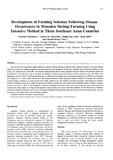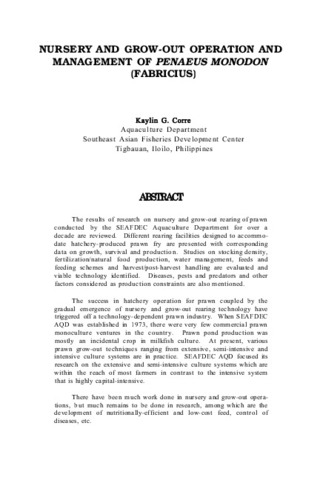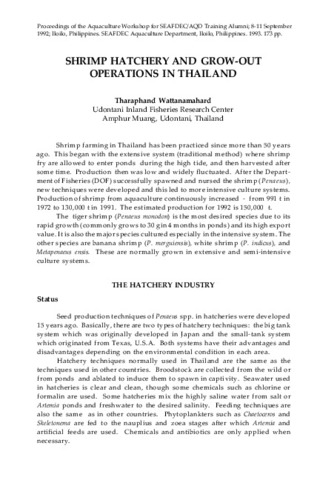| dc.contributor.author | Matsuura, Tsutomu | |
| dc.contributor.editor | Nakamura, Koji | |
| dc.coverage.spatial | Philippines | en |
| dc.coverage.spatial | Thailand | en |
| dc.coverage.spatial | Malaysia | en |
| dc.coverage.spatial | Southeast Asia | en |
| dc.date.accessioned | 2023-08-25T01:31:26Z | |
| dc.date.available | 2023-08-25T01:31:26Z | |
| dc.date.issued | 2006 | |
| dc.identifier.issn | 1341-710X | |
| dc.identifier.uri | http://hdl.handle.net/10862/6469 | |
| dc.description.abstract | This study is an investigation of the aquaculture methods used in brackish water fishpond culture mainly producing shrimp in the Philippines, Thailand and Malaysia. Extensive methods are practiced in the Philippines and Thailand (2 tons/ha and below for annual production of shrimp with no or few feeding method), while the intensive method is used in all the 3 countries (2 tons/ha and over for the annual production of shrimp with more feeding method). Most of the production of cultured shrimp relies on the intensive method. The yield of shrimp using the extensive method is relatively high in the Philippines, but small in Thailand due to declining water quality.
With regard to the intensive method, the Philippines has a low death rate for monodon (Penaeus monodon) because it has adopted the Green water system as a measure against bacterial disease (luminous bacteria). On the other hand, Thailand and Malaysia have low survival rates owing to the lack of effective measures to prevent virus disease (White spot). For this reason, an increasing number of farms have changed their main cultured species from monodon to vanamei (P. vanamei) in Thailand and Malaysia. Consequently, the price of monodon has been falling as a result of high production of vanamei at lower prices, and the profits of monodon farms continue to decrease.
If the cultivation of vanamei, which is a species introduced from South America, continues to increase, it is expected to have a negative effect on monodon farming. In order to protect monodon, a native species, it is necessary to focus on cultivating this species in Southeast Asia. In Thailand, there is a need to ensure the supply of good quality seedlings, since the quality of monodon seedlings has been deteriorating. In Malaysia, it is necessary to equalize the level of aquacultural techniques within the country because there is a disparity in techniques among fish farms. In the Philippines, both extensive and intensive methods are conducted in a sustainable manner. | en |
| dc.description.sponsorship | This study is the result of a collaboration among Japan International Research Center for Agricultural Science (JIRCAS), the Southeast Asian Fisheries Development Center/Aquaculture Department (SEAFDEC/AQD) in the Philippines, Kasetsart University in Thailand and Fisheries Research Institute (FRI) in Malaysia. | en |
| dc.language.iso | en | en |
| dc.publisher | Japan International Research Center for Agricultural Sciences | en |
| dc.relation.ispartofseries | JIRCAS Working Report; No. 44 | |
| dc.subject | Penaeus monodon | en |
| dc.subject | Penaeus vannamei | en |
| dc.title | Analysis of the sustainability of extensive and intensive methods in brackish water fishpond culture primarily producing shrimp in three Southeast Asian countries | en |
| dc.type | Book chapter | en |
| dc.citation.spage | 57 | |
| dc.citation.epage | 64 | |
| dc.subject.asfa | aquaculture | en |
| dc.subject.asfa | brackishwater aquaculture | en |
| dc.subject.asfa | shrimp culture | en |
| dc.subject.asfa | intensive aquaculture | en |
| dc.subject.asfa | extensive aquaculture | en |
| dc.subject.asfa | pond culture | en |
| dc.subject.asfa | sustainable aquaculture | en |
| dc.citation.bookTitle | Sustainable Production Systems of Aquatic Animals in Brackish Mangrove Areas | en |
| dc.subject.scientificName | Penaeus monodon | en |
| dc.subject.scientificName | Penaeus vannamei | en |
| local.subject | Philippines | en |
| local.subject | Thailand | en |
| local.subject | Malaysia | en |
| local.subject | monodon | en |
| local.subject | vannamei | en |
| local.subject | intensive method | en |
| local.subject | extensive method | en |



